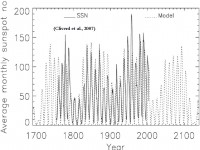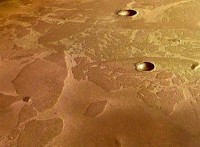Oct 03, 2007
A Challenge to the Carbon Dioxide / Global Warming Connection
By Jules Kalbfeld
One issue that seems to have been lost or avoided in the debate over the connection between atmospheric carbon dioxide (CO2) and global warming is the miniscule mass of CO2 that is being blamed for so many past, present and predicted natural disasters. The mass of atmospheric CO2 is extremely small when compared to the total mass of the Earth’s atmosphere and even smaller when compared to the combined masses of the land and water features on the Earth’s surface as well.
The directly proportional relationship that exists between the mass of any object and its heat capacity is essentially axiomatic: all other factors being the same, the larger the mass of an object, the greater its ability to capture, store, transport and release heat. Since the concentration of CO2 in the Earth’s atmosphere is so small, the notion that it is causing global warming seems to ignore this basic truth.
This discussion illustrates how the connection between global warming and the tiny mass of CO2 in the Earth’s atmosphere has been exaggerated. The challenge, expressed here, simply asks the proponents of CO2 induced global warming to reconcile their theories with classical scientific principles and established physical data.
See paper here.
Sep 24, 2007
Dr. William Gray’s Response to Trenberth’s Op Ed “Clarity Emerging on Hurricanes?”
By Dr. William Gray
The September 14, 2007 Op Ed piece “Clarity Emerging on Hurricanes” by Kevin Trenberth may have been timed to coincide with the congressional Senate hearing on hurricanes and climate change scheduled in the Dirksen Building on 19 Sept ‘07.
Trenberth’s central theme of emerging clarity on hurricane and climate change is, in my view, totally bogus as was his Scientific American article of July 2007 saying how hurricanes will change in the future. This article was very one sided and factually wrong in many places. It appears not to have been peer reviewed.
There is absolutely no clarity emerging on the question of human influence on hurricanes and hurricane changes associated with climate change. This dichotomy between the group of researchers saying that humans are likely influencing hurricanes (Trenberth is of this group) and the many others of us saying there is no solid evidence or physical basis for such a linkage is widening, not converging. Most of those believing that humans are affecting hurricanes have a vested interest that their views be accepted. Most of us skeptics do not.
The papers Trenberth cites in his Op Ed as backing a growing clarity on this topic have major flaws and are likely not accepted by most of us who are skeptical of significant human influences on hurricanes. There is no reliable evidence that Atlantic basin (or global) hurricane activity shows changes over the last century beyond the changes brought about by the oscillating Atlantic Ocean thermohaline circulation which appears to be driven by salinity changes. United States landfalling hurricane numbers (the most reliable long-term data we have) show a small decrease over the last century. This is particularly noticeable in US landfalling major (Cat 3-4-5) hurricanes. In the 41 year period between 1925-1965 there were 39 US landfalling major hurricanes. In the last 41 year period of 1966-2006 when global CO2 amounts were rising there were only 22 such US major hurricane landfalls. How can anyone honestly conclude that long term Atlantic hurricane activity is increasing?

Sep 23, 2007
Next Solar Cycle Late and Likely to be a Dud - the Implications
By Joe D’Aleo, ICECAP on paper by Clilverd et al. in GRL
In our All About Climate we talk about the solar cycle (soon to be updated in a paper to be published by the Fraser Institute) and using empirical methods to predict the solar and the likely results. We recently featured numerous papers that addressed this issue including this and this.
The current solar cycle is the longest since the early part of the 20th century. Solar minimum has yet to be reached, indeed there have been no signs yet of the start of cycle 24. In this paper in 2006 in the GRL, Clilverd et al. used a model for sunspot number using low-frequency solar oscillations, with periods 22, 53, 88, 106, 213, and 420 years modulating the 11-year Schwabe cycle, to predict the peak sunspot number of cycle 24 and for future cycles, including the period around 2100 A.D. The good hindcasting results suggest this methodology has promise and that weaker and colder solar cycles are in our future the next few decades. They expect cycles 24 and 25 will have peak sunspot levels between 40 and 50 (cycle 23 which peaked in 2000, had a peak of 120, cycles 21 and 22 peaked near 160). Low sunspot cycles of long length tend to bring about widespread global cooling.

Sep 21, 2007
Nobel Laureate Fears Growing Reliance on Grain-based Fuels Threatens World Food Supplies
By Tom Webb, Pioneer Press
In the food-versus-fuel debate, there’s little doubt where Norman Borlaug’s heart lies. The father of the “Green Revolution,” Borlaug’s life has been dedicated to increasing the food supply in the developing world. His work with grains is credited with saving millions of lives, and in 1970, he was awarded the Nobel Peace Prize.
Today’s food-versus-fuel debate has a new element since 1970: growing concern about global climate change. Count Borlaug as a skeptic. “I do believe we are in a period where, no question, the temperatures are going up,” he said. “But is this a part of another one of those (natural) cycles that have brought on glaciers and caused melting of glaciers?”
So Borlaug, now 93, watches with dismay as ever-greater amounts of the world’s grain are turned into motor fuel for developed nations. It isn’t going to solve our energy problems, and it’s going to disrupt our food system,” Borlaug said Thursday. See full story here (you will need to create a free account).
Sep 17, 2007
Mars, Like Earth, Has Cyclical Ice Ages, Study Says
By Brian Handwerk, for National Geographic News
Mars has gone through 40 ice ages during the past five million years that regularly send the planet’s permanent ice sheets cascading toward the equator, then melting backward, a new theory suggests. The climate changes are likely driven by cyclical fluctuations in the planet’s orbit that alter the amount of sunlight that falls on the planet’s surface, says astronomer Norbert Schörghofer of the University of Hawaii at Manoa.
Understanding the sun’s exact role in the Martian ice ages could help solve longstanding puzzles about the red planet. It could also help scientists better understand Earth’s complex
climatic systems, which are also affected by orbital variations. The new theory appears in this week’s issue of the journal Nature. See National Geographic News story here.
In recent years extensive amounts of ice have been discovered below the surface of Mars. Much of the ice mysteriously survives far from the planet’s poles. (Related photo: “‘Frozen Sea’ Seen on Mars [February 23, 2005].)

A first examination of the theory will arrive with the Phoenix lander, already en route to Mars for a 2008 landing. The craft will try to sample Martian ground ice, and the results could make or break Schörghofer’s theory. (Related photo gallery: ”Phoenix Lander’s Search for Mars Water” [August 3, 2007].)
|





